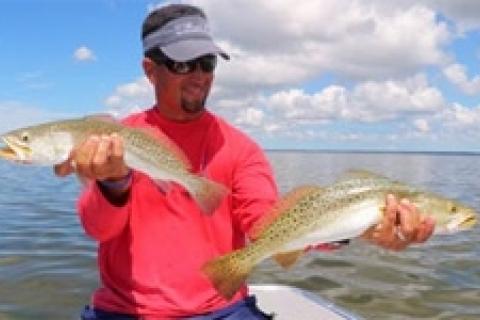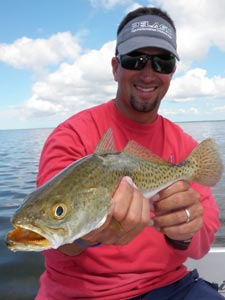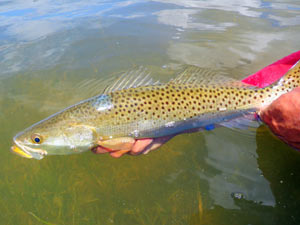
 |
| Seatrout have one or two fang-like teeth that makes them an effective predator. |
Spotted seatrout, also known as "specks" or "spotsides" along the Gulf States, have a large distribution on the southeast "corner" of the United States. In practical terms, this means a stretch of fishable inshore water from the Carolinas all the way to the Texas Gulf Coast. I have personally caught loads of them on the grassflats off downtown Campeche, Mexico.
Seatrout are considered the most sought after inshore gamefish for the state of Florida. It appears redfish are catching up to that number one category, but the relative ease of catching seatrout will always make fishing for this marvelous species immensely popular.
Keep these important things in mind when pursuing seatrout:
- Low light fishing whenever possible — cloudy days are often better than sunny days.
- Grassflats during pleasant weather — deeper water, canals and dock shadows when very hot or very cold.
- Seatrout prefer a temperate world, a bit like bonefish (although the former can tolerate infinitely colder water) so think spring or fall in a pinch.
- Big baits equal big seatrout, and "gator" trout love finfish baits versus shrimp.
- Consider the seatrout as a non migratory inshore fish that will spend its life cycle around the grassflats. It does not have the movement range of the snook, which has a wider sweep from brackish canals to ocean inlets.
- Seatrout should be thought of as inshore raptors. They are apex predators that feed along the entire water column by seizing prey in their fanged mouth. Big trout have been known to consume large needlefish as well as smaller trout.
- Seatrout can be thought of as schooling fish when the fish are of one to three pound average size. Large trout (specimens over four pounds) tend to be solitary.
- All seatrout are attracted to sound. Saltwater poppers (especially those with a cupped face)and popping corks that disturb the surface should be used frequently as attractors.
- The term "grassflat" should be thought of loosely in the sense that though seatrout can live over a variety of mottled bottoms of sand, stretches of oysters and structure, they generally live in proximity to forested bottom.
- Seatrout live an inshore, nearshore life. This includes waters very saline like the shallow ocean of Savannah, Georgia to the brackish bays of the Carolinas and Texas. The vegetation can be as diverse as marsh grass to red mangroves.
- Despite their pugnacious nature, seatrout have very soft mouths and hook tear-outs are a risk. Consider using S-glass rods, monofilament line instead of braid, and carry a landing net if you are fishing from a boat.
Seatrout Fishing Tactics
There are many methods of pursuing seatrout, but they generally break down into one of four categories or some combination of these elements: drifting, wading, focused casting to potholes and muds from a vessel, anchoring and chumming from a vessel.
Drifting for Seatrout
Drifting for seatrout is a classic method that involves allowing a breeze-blown vessel to slowly "troll" your offerings on the windward side. Some people feel the vessel goes over the fish and spooks them before the baits ever reach the fish. My experience indicates that if the baits are fished a long distance from the boat, trout will have had an opportunity "re-group" if spooked. In addition, if one is using a popping float, the popper will either re-entice any spooky trout or else "call in" new fish.
 |
| Seatrout are Florida's most sought after inshore gamefish. They often appear in schools, providing great action. |
Drifting is wonderful to cover lots of water and also for when the bottom is too soft to wade. However, this method is dependent on some breeze and cannot be done in becalmed water. When there is a good drift, I'd suggest having two anglers in the vessel fishing in two different ways. The first angler should make long casts downwind to brand new water that the boat has yet to drift over. This is best accomplished by using a soft plastic swimbait on a light-weighted jig head and working it back to the boat. The second angler would be fishing on the other side of the boat (the upwind side) with a popping cork with a mullet strip or soft plastic shrimp underneath. Incidentally, the distance between the cork and the bait should be adjusted for water depth and for probing the exact "strike depth."
Wading for Seatrout
Wading has grown more and more in popularity. But it requires a bottom that can support the weight of the wader, which a lot of trout bottom does not. Additionally, wading requires use of a boat as transportation from spot to spot since deeper channels and simple fatigue prevent vast areas being covered on foot.
What wading does provide is the kind of stealth that a drifting or poled vessel cannot provide. The wader is low in the water and is far more camouflaged than a skiff. This is especially important when the quarry is the huge but very cautious "gator" trout. The actual wading method should be a slow deliberate pace, but with the kind of easy shuffling step that will dislodge any stingrays immediately ahead. Seatrout are attracted to loud pops since they interpret this as feeding activity, but they flee from the "pressure wave" of something large pushing through the water, so wade slowly and softly!
For those waders that keep some trout for the table, it's inevitable that the vanquished fish will be dragged from a floated stringer tethered to the wader's belt. The threat of a shark taking a bite out of one of your tethered trout is real, so be sure your catch is towed a safe distance from your torso.
Casting for Seatrout
Focused casting from a vessel to mullet muds or potholes can be accomplished by using poling or electric motors as propulsion. I favor the use of poling as the quieter approach, especially when fishing ultra-shallow grassflats for very big trout. If one insists on using an electric trolling motor, be sure to keep the RPM's slow and constant.
Mullet muds are areas of stirred up bottom clouding the water column. In this case, it is caused by mullet feeding on the bottom. This activity kicks up all manner of edible life forms, which, in turn, draw in the seatrout. Always be sure to cast to the densest, "freshest" parts of the mud, which has the most actual "real-time" activity. Casting to visible potholes, which can hold big trout, necessitates thorough lure retrieval coverage and speaks for itself. Both these methods call for using artificial lures like the YUM line of plastic baits. I personally like the Money Minnow style for targeted casting to muds and potholes.
Chumming for Seatrout
Chumming for seatrout will surely strike some anglers as a novel idea, but the truth is that, under the right directional convergence of wind, current and tide, it is just as successful as chumming for mackerel. I have been using this method in Miami's Biscayne Bay for over 25 years and can attest to its effectiveness.
The secret to chumming for trout is to let the scent and small ground fish bits catch the fish and pull them in via a "double-chum" situation. This means that the first fish to respond to the chum behind the boat are pinfish, which will gather at the stern of the vessel. All of this baitfish activity should eventually ring the dinner bell for seatrout, which will be pulled in by the chum's scent, as well as the unusual bunching of so many pinfish. The next step, once the aggregation of pinfish occurs, is for the anglers to fish finfish baits like mullet strips and pinfish steaks way BEHIND the pinfish clouds off the stern.
- 17805 views

